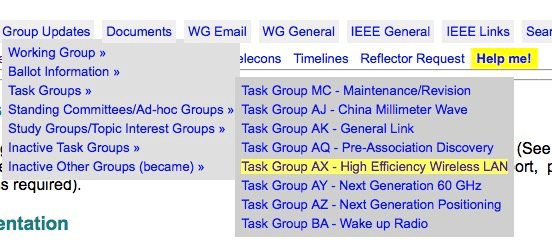 Where do the standards for Wi-Fi come from? You might already know they come from the IEEE. You've probably seen "802.11" or "IEEE 802.11" referenced at some point. The IEEE is the Institute of Electrical and Electronics Engineers. The IEEE is made up of (you guessed it) electrical and electronics engineers, but also IT professionals, computer researchers, and other people in related professions. Among other activities towards advancing technology, the IEEE has a number of committees that create a whole slew of standards. Let's look at how an idea becomes a standard. It may actually be more complex than how Bill becomes a Law (for those of you old enough to remember Schoolhouse Rock.)
Where do the standards for Wi-Fi come from? You might already know they come from the IEEE. You've probably seen "802.11" or "IEEE 802.11" referenced at some point. The IEEE is the Institute of Electrical and Electronics Engineers. The IEEE is made up of (you guessed it) electrical and electronics engineers, but also IT professionals, computer researchers, and other people in related professions. Among other activities towards advancing technology, the IEEE has a number of committees that create a whole slew of standards. Let's look at how an idea becomes a standard. It may actually be more complex than how Bill becomes a Law (for those of you old enough to remember Schoolhouse Rock.)
For our purposes, we are going to focus on the IEEE 802 LAN/MAN Standards Committee. The "802" is the committee number assigned to the LAN/MAN standards committee. The 802 committee has Working Groups (WG) that work on specific technology areas within the overall LAN/MAN space. Each WG is assigned a number in the order of their creation, so the 11th WG of the 802nd IEEE standards committee is the 802.11 Wireless LAN Working Group. This 802.11 WG creates the 802.11 wireless standards.
You may be wondering who is in this WG that creates the standards? Since the standards will dictate how manufacturers make their devices work, the WG is made up mostly of people from the vendors. Being on the standards committee is a decent time commitment with travel involved, so it helps if your employer wants you spending time on that and can financially support it. It's obviously in the interests of the various vendors to have input into these standards, so representatives from these vendors make up the bulk of the WG members.
This much sort of explains how we get 802.11, but what about standards like 802.11ac? The process for making changes and enhancements to these standards is called an amendment. Amendments are created by a Task Group (TG) that works within the WG. Task groups are named with letters, skipping a few letters to avoid confusion (like l). When all the single letters are used up, they go back to 'aa', 'ab', 'ac', and so on. For example, when the 802.11 WG decided they needed to create an IoT optimized version of wireless, they created Task Group ah or "TGah" to design an amendment to the 802.11 standard to provide for Sub 1GHz wireless.
So how do we go from a work group or task group to a standard? Here's the cycle from the IEEE web site: It starts with project initiation. Let's use TGah as an example. For this amendment, TGah is formed. This group will discuss the goals of the standard and begin discussing and suggesting the technical changes required to achieve their stated goals. This eventually results in a series of "drafts." These are close to what the final standard will be, but not the final standard.
It starts with project initiation. Let's use TGah as an example. For this amendment, TGah is formed. This group will discuss the goals of the standard and begin discussing and suggesting the technical changes required to achieve their stated goals. This eventually results in a series of "drafts." These are close to what the final standard will be, but not the final standard.
If you've been around wireless a while, you might remember when consumer gear started coming out with "draft n" equipment. It was based on one of these pre-release versions of the 802.11n standard. Once the task group decides they are done, they will vote on whether to submit their final draft to the 802 Executive Committee, who will in turn to send it to the IEEE Revision Committee (RevCom). RevCom then approves this revision to the standard. Phew!
So, using this bit of knowledge of the process, you can actually begin to follow the status of any amendments you are particularly interested in. At the 802.11.org website, investigate the Task Groups menu and you will see a list of the current TG.
 For example, if you go to the Task Group AX page, you'll see that they have completed their first draft of the amendment and the current timeline has the amendment being sent to RevCom in December of 2018. You can learn a lot about what's coming and what you need to prepare for by keeping an eye on the TG pages. You can learn a lot diving into their documents, too.
For example, if you go to the Task Group AX page, you'll see that they have completed their first draft of the amendment and the current timeline has the amendment being sent to RevCom in December of 2018. You can learn a lot about what's coming and what you need to prepare for by keeping an eye on the TG pages. You can learn a lot diving into their documents, too.
I find it the open process used by the IEEE valuable. By keeping track of what the task groups are doing, I can stay ahead of the game on what's coming and that leaves me and my customers in a better position to make intelligent decisions. I hope you find it useful as well!




